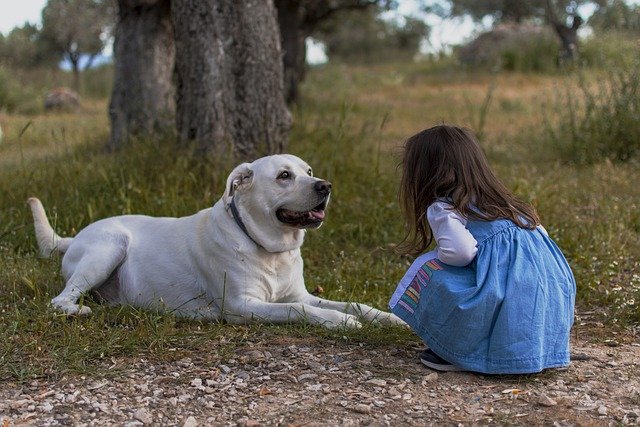The badge of honor for many trainers is a highly reliable recall. It can take hours and hours of painstaking foundation work and training with distractions before finally reaching the Holy Grail of recall training: distance and distractions. I was pretty smug. Sandy Mae repeatedly came when called from distances of more than 200 feet from distractions such as horse dung (a delicacy to her) and fast-food wrappers (second only to horse dung).
I was glad her recall was so solid because she appeared to be increasingly distracted, often wandering off in the opposite direction. Although she came with great enthusiasm and speed each time I called (for which I generously rewarded her), it was getting tedious calling her all the time to keep her with me and the other dogs. She was driving me to distraction!
One day I watched as she turned around and retraced our route. What was so interesting back there? She trotted about 100 feet out, slowed down, and turned to look at me. It was clear from her expression: “Well, aren’t you going to call me?”
Sandy Mae had trained me very well without me realizing it. In my eagerness to keep adding distance to our awesome recall, I always called her from farther and farther. I had actually been rewarding a “behavior chain.”
A behavior chain is when two or more individual behaviors are linked together to form a new behavior, typically rewarded when the last link is performed. Sandy’s behavior chain was 1) run a distance away and 2) come when called. In her mind, she needed to perform 1 before 2.
Behavior chains are commonly used to our advantage. An example is the retrieve during which several individual behaviors are linked together to form the final goal behavior. The individual links are: a) the object (a dumbbell or any other object) becomes salient or noticeable to the dog; b) he opens his mouth and grasps the object; c) he holds the object; d) he walks with the object; e) he releases the object when cued. Each of these, of course, can be broken down even further, but clearly, the retrieve is a behavior chain.
Most of us are familiar with using behavior chains to teach agility skills such as the weave poles or contacts. For example, the contacts include training several separate behaviors: a) touch nose to a flat target; b) get on a board; c) run with confidence on the board; d) run with confidence to the target and touch it.
Harder to recognize are behavior chains that we never intended to teach such as Sandy training me to call her. Here are some important things to know about behavior chains:
• Each link in a behavior chain is forged by its reinforcement history. That one link or separate behavior has been rewarded; otherwise, it would not be occurring. If that link has a very strong history of reinforcement, it can take more time and diligence to eliminate. Think of dogs that have been reinforced for jumping on people and how difficult it can be to extinguish that, especially if it has been reinforced for a long, long time. (This also speaks to why it is so important to richly reinforce each link in chains we do want.)
• Some behavior chains result from training alternative behaviors to replace behaviors we don’t want. I call these “hitchhikers.” Again, in the example of a dog that jumps on people, we often teach a sit to replace jumping. Many dogs learn to jump to get attention and then sit, for which they get reinforced. If you do that, you have just reinforced a new behavior chain, i.e., jump then sit. To solve this problem, use a high rate of reinforcement for the new behavior and be careful not to reinforce any hitchhiker behavior. Carefully observe your dog to be sure that you only reinforce the new alternative behavior and not both the old and the new.
• Use a “disassociation period” of at least a couple of minutes to break the behavior chain. To disconnect – in the dog’s mind – a reward for behavior you don’t want, be sure you wait a period of time before doing anything that could be reinforcing. For example, if your dog barks at you for attention and then stops on his own, and you immediately reinforce him for stopping, you have actually reinforced the barking. Make sure you wait at least a couple of minutes before cueing him to work or rewarding him for being quiet.
• A cue is reinforcing. If your dog is mugging you for treats and you cue a sit and then reward the sit, you’ve also reinforced mugging. Any cue you give your dog reinforces whatever she is doing at the time of your cue. A cue is attention and attention is reinforcing. And for many agility dogs a cue to work is the jackpot of all.
Here are some common behavior chains inadvertently trained by agility handlers:
• Running away to be recalled. Like Sandy, some dogs learn that if they run off from their handlers, they will be called back and rewarded for coming when called. Instead, reinforce your dog for staying with you while you talk with your instructor or are otherwise distracted (often a cue for a dog to run off).
• Looking away on the start line. Some dogs learn that when they look away from the handler on the start line, the handler will cue a “Watch Me” or call for their attention. Then, when the dog responds to the cue, the handler rewards him with a treat or by releasing him to take the first jump. Instead, reward your dog for watching you as you lead out. Never release your dog from the start line if he is looking away! This reinforces looking away (and risks a knocked bar on the first jump, as well as lackadaisical speed from the start line).
• Getting up on the start line. The start line is the bane of existence for many agility competitors. We inadvertently train “elevator butt” when we fail to adequately reinforce a non-fidgety sit with a high enough rate of reinforcement. If your dog gets up or fidgets, don’t recue the sit and then reward when he sits. You would be unwittingly rewarding elevator butt or scootching. Instead, walk the dog away from the start line, take a brief timeout, and then try again.
• Sniffing. Some dogs learn to sniff the ground so that their handler will cue “Leave It” for which he is rewarded. Instead, reward him for paying attention to you, or put him in a crate or on a Down-Stay if you can’t pay attention to him.
• Barking. Many dogs learn to bark for attention. It works for your dog if you then look at him, tell him to shush, and then reward him for being quiet. A disassociation period is critical in cases involving barking.
Dogs are brilliant. It is amazing what they are capable of learning. We just have to stay one step ahead of them to be sure they are learning precisely what we want them to learn.





